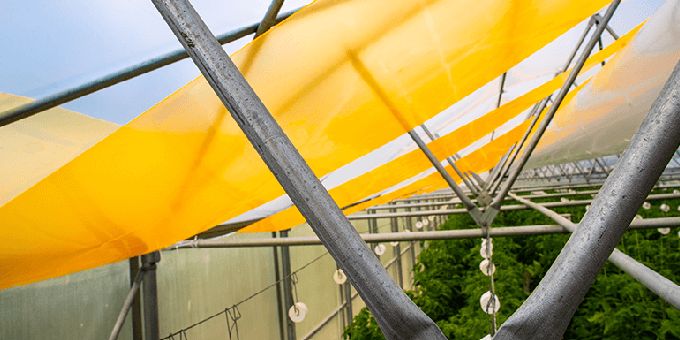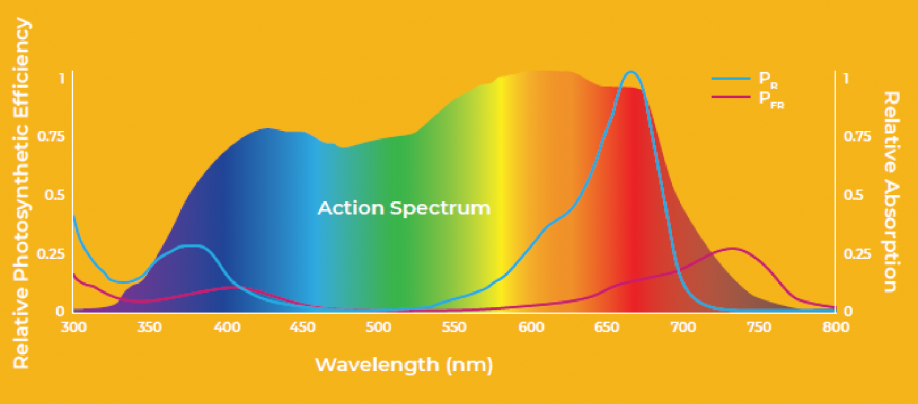But how do plants interact with light? There are three main types of interaction: absorption, reflection, and emission. What does each of them mean in the context of plants? How do they differ from each other?
 Light Interaction With Plants: Reflection, Emission and Absorption
Light Interaction With Plants: Reflection, Emission and Absorption

Article from | UbiGro
As a commercial farmer, you are probably aware of the significance of light in greenhouse farming and its impact on both growth (photosynthesis) and development (plant shape). Without enough quantity of light, crops won’t photosynthesize, i.e., they’ll be unable to convert water and carbon dioxide into oxygen and chemical energy (glucose). The chemical energy from photosynthesis produces plant food, which is responsible for plant growth. And without the proper spectrum (color mix), plants will not have the desired shape or morphology.
But how do plants interact with light? There are three main types of interaction: absorption, reflection, and emission. What does each of them mean in the context of plants? How do they differ from each other? We’ll answer these questions in this article, along with the role of UbiGro films in enhancing plant growth.
Reflected light
To explain how plants reflect light and the type of light they reflect, it helps to understand why plant tissue is green in the first place. An essential chemical known as chlorophyll is responsible for the green hue of leaves and plants. What is the role of this chemical in green plants?
Chlorophyll absorbs solar light energy and converts carbon dioxide and water into glucose and oxygen; it is the main ingredient behind photosynthesis. Chlorophyll is referred to as an essential pigment because it is the only pigment capable of taking in light energy and transforming it into chemical energy. Among its various roles are:
- absorbing and trapping solar radiation within the plant
- aiding in the production of carbohydrates, which are essential for the plant as a whole, and
- facilitating the uptake and assimilation of soil minerals.
Chlorophyll absorbs a broad spectrum of wavelengths of light, but most strongly absorbs red and blue light (99% absorption). Blue and red light is reported to be the most ideal for assimilating carbon dioxide. However, the green wavelength band (495–570 nm) is not absorbed as strongly (only ~85% absorption) as other colors, and so most of the reflected light from plants is green.
While chlorophyll is the primary pigment responsible for the green color of plants, other pigments like carotenoids (which reflect red, orange, and yellow light) and anthocyanins (which reflect red, purple, and blue light) can also be present in plants and contribute to their coloration, which is a product of the plants’ reflection properties.
Emitted light
Light emission from plants refers to light that originates from the plant itself, as opposed to reflected light whose origination is not from the plant.
Bioluminescence in plants
Living organisms, including plants, can emit light through a process known as bioluminescence, which is produced by biochemical reactions within the plant. This phenomenon is most commonly seen in certain species of algae and fungi, but some plants also have bioluminescent properties, such as the “shining” plants in the genus Kalanchoe. However, bioluminescence in plants is relatively uncommon. However, the development of knowledge about bioluminescence has led to the development of genetically altered plants with biological luminescence.
Bioluminescent genes from bacteria and fungi, for example, Shewanellaceae, Vibrionaceae, and Mycena have been employed by scientists to create plants that can glow. A plant typically used by scientists in testing bioluminescence is tobacco, with leaves that produce a neon green glow from budding to maturity.

Chlorophyl fluorescence
Another light emission mechanism from plants is chlorophyll fluorescence, a process where plants emit light in the visible spectrum as a byproduct of photosynthesis. It occurs when chlorophyll molecules absorb light energy, and then release some of that energy as a faint glow.
Chlorophyll fluorescence is caused by the absorption of light energy by chlorophyll molecules within the photosynthetic apparatus of plant cells. When chlorophyll molecules absorb light energy, they become excited and enter a higher energy state. Some of this excess energy is then emitted as fluorescence, which can be detected using specialized equipment.
The amount and pattern of chlorophyll fluorescence emitted by a plant can provide valuable information about its physiological state, including its photosynthetic activity, stress levels, and overall health. For example, changes in chlorophyll fluorescence can be used to monitor the effects of environmental stressors, such as drought or pollution, on plants, or to track the development and maturation of crops.
Absorbed light
Unlike emitted or reflected light, which is light coming off plants, absorbed light is the light taken in by plants. Light is absorbed by plants primarily for photosynthesis. However, not all wavelengths of light are used by plants in converting carbon dioxide and water to glucose and oxygen. Plants are only able to use visible light from 400 – 700 nm to drive photosynthesis. This range of wavelengths is known as photosynthetically active radiation, or PAR. Recent studies have shown that the active range should be extended to ~750 nm, to include some far-red light, and this regions is known as extended PAR, or ePAR.
Light-dependent reactions
During the light-dependent reactions of photosynthesis, light energy is captured by chlorophyll and other pigments in the thylakoid membranes of the chloroplasts, and this energy is used to power a series of electron transport chains. Light-dependent reactions include the following:
- Light energy stimulating photosystems.
- Water photolysis and reduction of NADP+(nicotinamide adenine dinucleotide phosphate).
- Adenosine triphosphate (ATP) synthesis using the electron transportation chain.
Light-dependent reactions transform sunlight into glucose, the carbohydrate form of chemical energy. Energy for all green plants comes exclusively from photosynthesis.
The light reaction occurs within the granules of the cells’ chloroplasts, releasing ATP, NADPH, and oxygen. Although the leaf is a plant’s primary organ for photosynthesis, chloroplasts are found in all of the plant’s green parts.
A grana (plural: granum) is a stack of flattened thylakoid membranes found within the chloroplasts, which are specialized organelles responsible for photosynthesis. Grana are found in the stroma, enclosed by a double membrane surrounding the chloroplasts. Chlorophyll is one of the pigments present in the granum and is the most vital element of photosynthesis, which occurs in two phases: the light stage and the dark stage. The biosynthetic phase of photosynthesis takes place in the dark stage, while the photochemical phase occurs in the light-dependent stage.
Factors that affect light absorption by plants
For photosynthesis to occur effectively, several factors must first be met. The following are some elements that influence a plant’s ability to absorb light:
- Leaf structure: Leaves have varying levels of thickness. The thinner the leaf, the better it is at absorption.
- Light intensity: A leaf’s ability to absorb light increases with its exposure to light.
- Light wavelength: Specific wavelengths, for example, red and blue, are absorbed more efficiently by plants.
- Duration: The longer leaves are exposed to light, the more of it they absorb.
- Environmental conditions: Low humidity levels can result in water loss through transpiration, hindering a plant’s capacity to absorb light.
Why is understanding reflected, emitted and absorbed light important?
Light, whether reflected, emitted or absorbed by plants, is essential for the growth and production of crops. Understanding the various types of lights that affect plants is important for serious home growers and cultivation directors alike. It enables you to optimize your farming conditions for the highest quality yield possible.
As mentioned above, various factors affect the amount of light absorbed by plants which in turn affects the amount of food and energy produced. For instance, plants absorb more light in less humid environmental conditions, and you could therefore provide an optimal environment with low humidity to enhance photosynthesis, especially in a greenhouse.
Enhancing light absorption with UbiGro
A crucial aspect of commercial farming is improving the quality of sunlight your plants receive. If you’re invested in cultivating cannabis, vegetables, leafy greens, or ornamentals, insufficient light exposure or improper light spectrum will lead to stunted growth and, ultimately, low yield.
An ideal solution to improving the spectrum of sunlight in your greenhouse environment without the use of electrical lighting is UbiGro’s quantum dot greenhouse film. To enhance the quality of the light in the greenhouse, our luminescent layer makes use of advanced nanotechnology called quantum dots, providing the necessary lighting conditions for your crops to thrive without adding energy costs.
UbiGro’s adaptable hardware is compatible with every greenhouse, regardless of size, façade material, shape, etc. UbiGro’s cutting-edge greenhouse Inner layer has led to a 16% boost in dry-trimmed cannabis yield, a 21% improvement in tomato production, and a 28% boost in strawberry production. Reap the fruits of quality farming and get a free quote today!
The content & opinions in this article are the author’s and do not necessarily represent the views of AgriTechTomorrow
Comments (0)
This post does not have any comments. Be the first to leave a comment below.
Featured Product


